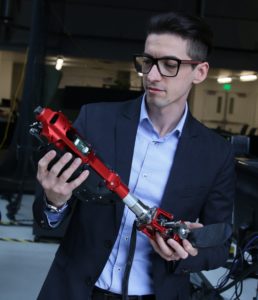 University of Utah mechanical engineering assistant professor Tommaso Lenzi and his team at the Bionic Engineering Lab have developed a new adaptive controller for their Utah Bionic Leg that enables an amputee to control the powered prosthesis. With this new controller, individuals with an above-knee amputation can walk at their preferred speed and cross obstacles of different sizes instead of having to go around them.
University of Utah mechanical engineering assistant professor Tommaso Lenzi and his team at the Bionic Engineering Lab have developed a new adaptive controller for their Utah Bionic Leg that enables an amputee to control the powered prosthesis. With this new controller, individuals with an above-knee amputation can walk at their preferred speed and cross obstacles of different sizes instead of having to go around them.
This new capability is highlighted in the latest issue of Science Robotics. In addition to Lenzi (pictured, right), the paper’s co-authors include graduate students Joel Mendez, Sarah Hood, and undergraduate Andy Gunnel.
The Utah Bionic Leg is a computerized and motorized prosthetic for leg amputees that is powered and can help users walk with ease. The leg uses custom-designed force and torque sensors as well as accelerometers and gyroscopes to help determine the leg’s position in space. Those sensors are connected to the onboard computer processor that interprets the signals to determine the user’s intended movements. Based on that real-time data, the computer then controls the motors in the prosthetic joints to assist the user with the intended activity.
Typically, robotic leg prostheses use preplanned movements, which means they play back a movement recorded from a non-disabled individual while walking. Some robotic leg prostheses use machine learning or other methods to determine which of a handful of movements the prosthesis should perform. This method only allows the prosthesis to be updated once every step. However, when a non-disabled person walks, no two steps are the same based on the variability in the environment. A person also changes a step halfway through completing the step. For example, when encountering an obstacle, we lift our foot up and then forward to cross it.
None of this is possible by using the same pre-recorded movement at each step. And with such high variability between steps, its nearly impossible to detect the small differences in the environment to accurately predict and classify the proper pre-recorded movement to perform for that step.
To address this issue, Lenzi and his team has developed a new controller that adapts to the movement of the user. This controller continuously looks at the user’s movement and updates the trajectory of the robotic leg 1,000 times each second to replicate what the biological leg would do in similar conditions.
“Like the biological leg, with this controller each step is different,” Lenzi said. “When the user encounters an obstacle, he or she can just cross it by doing what they would do with their biological leg. No need to stop and go around it.”
So far, a dozen people have tried this prototype in the laboratory. Soon, Lenzi will let subjects take a new version of the Utah Bionic Leg home to see how it performs in real-world conditions.
To see how the leg works, watch the video below.